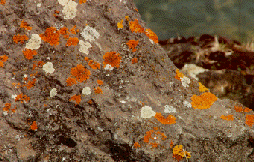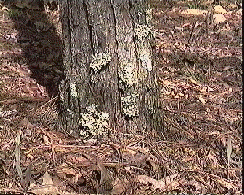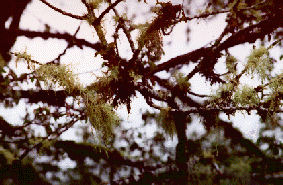Lichens
Index
Types of Lichens
Lichen Growth Forms

Crustose (crusty)
- edges flat, unlobed and closely attached to substrate
- hard to remove without damaging substrate or lichen
- algae usually dispersed
- edges unlobed (leprose and squamulose included here)

Foliose (leafy)
- A sandwich of fungal layer with algal mat in middle
- circular growth, lobes
- small rootlets called rhizines attach it to substrate
- top and bottom layers different

Fructicose (shrubby)
- round branches with its fungal layer outside, its algal layer within
- no rhizines
- vertical growth pattern
- odd-shaped structures such as globets; threads
- Fruticose lichens are either shrub-like small mounds, growing up from the ground, or beard-like, small tangles looking a bit like spanish moss when hanging down, attached to the substrate only at their bases, and usually with a circular cross-section.
In addition, Leprose lichens are powdery masses with little or no organized structure; Squamulose are much the same as crustose, but have raised edges, which can be folded and lobe-like.
All but fruticose lichens grow slowly; their growth, about .5 to 5 mm per year measured by the expansion of their circles. Fruticose lichens, on the other hand grow vertically, and quickly, up to 2 cm per year. Left unchallenged, undisturbed and with a suitably long-lived substrate, it is quite common for a lichen to have a lifespan of several centuries; in fact a certain arctic specimen of a crustose lichen, Rhisocarpon geographicum, was found to be about 9000 years old!
Back to Lichens Index
© 1997 TERC. All rights reserved.